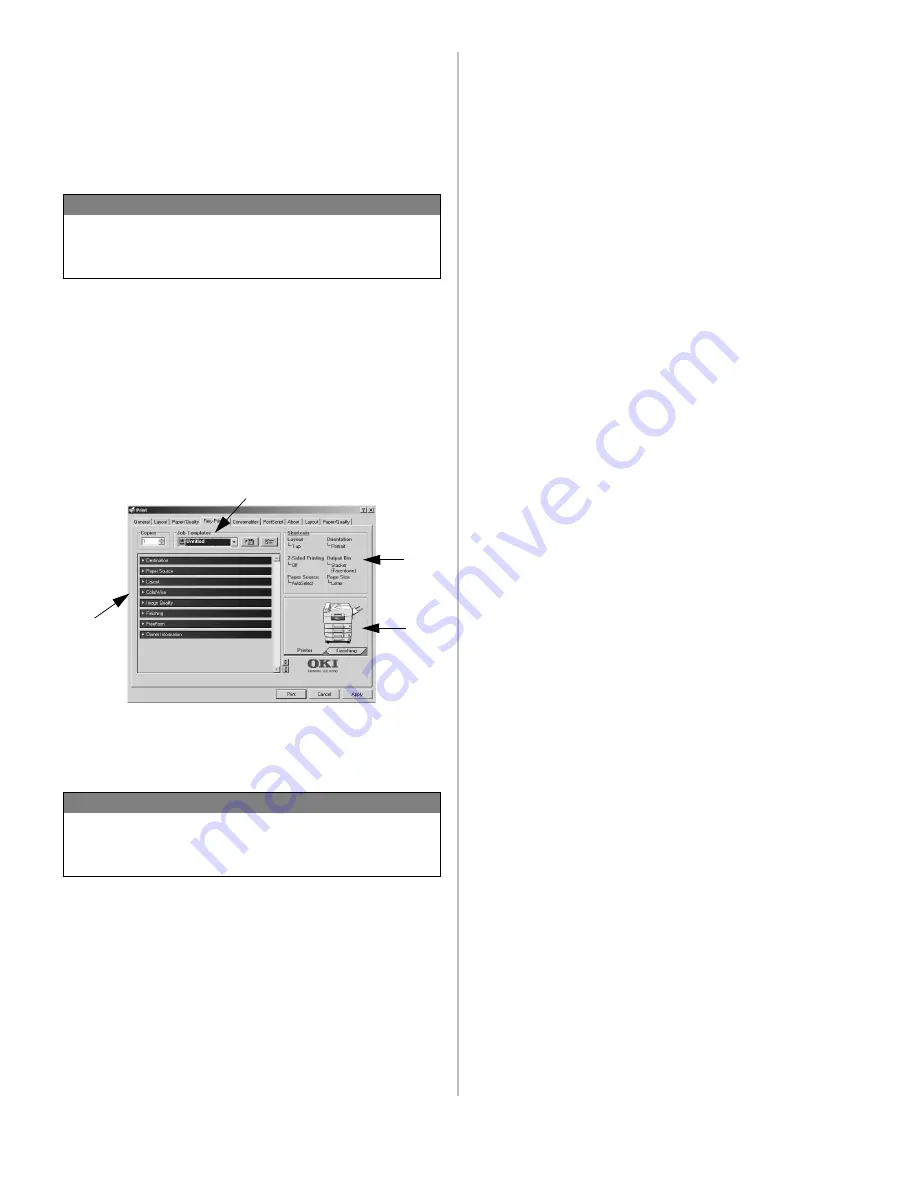
59384401
Using the Fiery PostScript Driver
The Fiery driver includes advanced features and
utilities. Many of these are designed for use in
professional graphics environments. Normally
they’re only used by a system administrator who
controls printing by all users on a network. You
don’t need to use them when printing most
business documents.
A Quick Tour of the Fiery PostScript
Driver
Although the Fiery PostScript driver looks different
from most drivers, it does basically the same
things—and more. You can get to the driver in the
normal way: From your application, click
File
→
→
Properties. Then click the Fiery
Printing tab.
The Fiery driver window looks like this:
1. Print features.
Click on the bar to expand selections
for each category. Hold the cursor over a bar to see the
features in each category.
2.
Click [Printer] to see the printer configuration. Click
[Finishing] to see a representation of page formats
(e.g., 2-up, landscape, mirror image).
3. Shortcuts
.
Click a feature name to go directly to the
bar controlling that feature so you can change it. Click
[Shortcut] to change the features listed in this area.
4. Job Templates
.
Use this area to name and save a
collection of settings so you can use it again for similar
documents.
For details on the Fiery driver interface, see the
EFI
Printing Guide
, Chapter 1.
A Note on the PCL Drivers
PCL
®
and PCL6
®
printer drivers are included with
your printer. These are provided mainly for HP
®
compatibility and for use with legacy systems. For
details on using them, see the
MFP Printing Guide
.
Graphic Arts Use
Most graphic arts environments are on a network.
The graphic artist as
end user
uses the Fiery driver
to print either to the Hold queue or the Print queue.
An Administrator uses Command Workstation
(Windows) or Command Workstation LE (Mac) to
administer the flow of files from the queue to the
printer and to control printer settings as needed.
The Fiery controller built into your MFP gives you a
wide range of capabilities for professional level
graphic arts applications. These features are
detailed in a series of electronic documents on the
Documentation CD.
Here is a brief outline of the EFI Fiery documents,
what they contain, and whom they are intended for.
Keep in mind that the amount of control end users
have over their print jobs depends on how the
workflow is set up in a particular organization.
Therefore you may need to refer to other
documents as well.
For the Graphic Arts End User
•
EFI Printing Guide:
This explains how to print
using the Fiery driver in Windows the Mac OS,
and UNIX. It describes the user interface and
how to customize it for your individual
preferences.
•
EFI Color Reference Guide:
This provides a
general overview of color management for
printing, including a glossary of color terms. It
also gives some guidelines for color printing
with specific applications.
For the Graphic Arts Administrator
•
EFI User’s Software Installation Guide:
Explains how to install and configure Fiery
software.
•
EFI Configuration Guide:
This explains Fiery
setup on a network and how to configure the
Fiery components. It also describes Fiery
administrative features on a network.
•
EFI Job Management Guide:
This explains how
to use the tools provided for Fiery job
management. It includes details on Command
Work Station, the Administrator’s primary tool
for controlling workflow.
•
EFI Color Guide:
This gives details on
ColorWise Pro Tool, a set of features and
utilities that help the administrator manage
color printing. It includes Profile Manager,
Color Editor, and Spot-On (GA version only).
NOTE
To administer printers on a network, you can use
Oki Job Accounting or PrintSuperVision. See the
Utilities Guide for more information.
NOTE
“Destination,” “FreeForm,” and “Owner
Information” are used in networked graphics
environments
1
2
3
4




